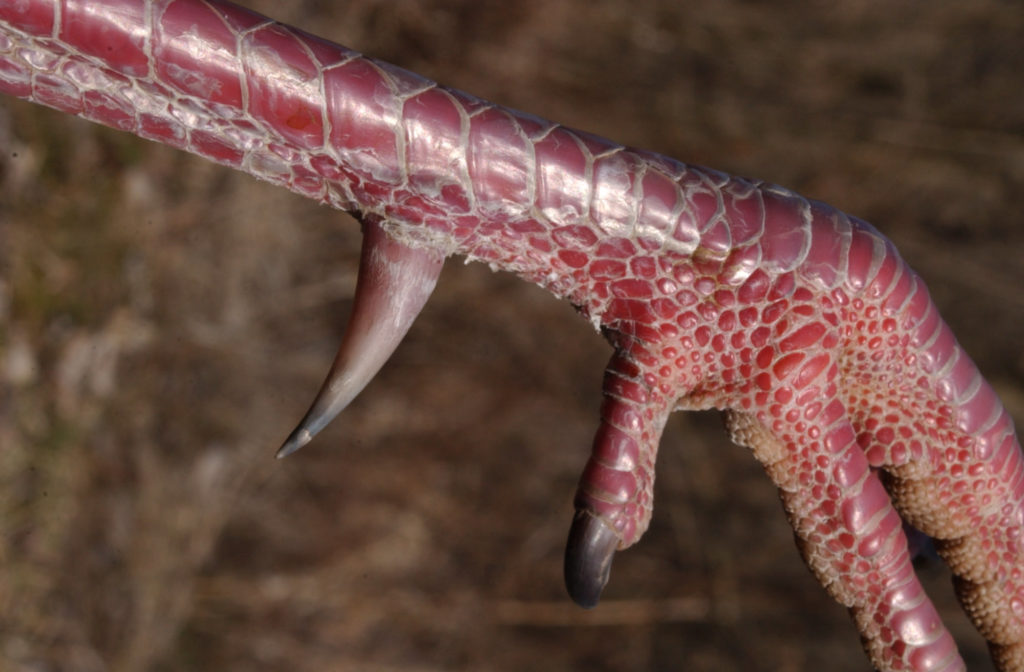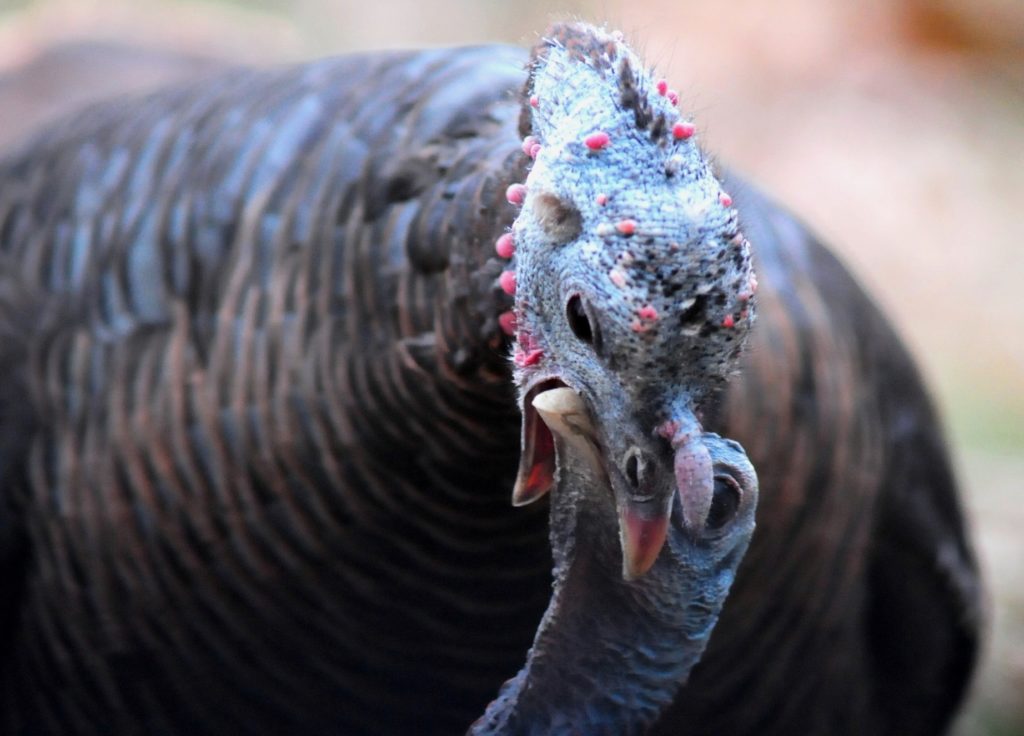Photography courtesy of Lowell Washburn, all rights reserved.
Blessed with extraordinary hearing, keen eyesight, and a profound ability to detect danger; the eastern wild turkey is America’s most challenging gamebird. The Long Beard’s instinct for survival is legendary. No other creature has been the subject of more hype, myth and folk lore than the elusive gobbler. In spite of major technological improvements to shotguns, ammunition, archery tackle and other turkey hunting equipment; the bird remains as difficult as ever to bring to bag. During an average year, only one in four Iowa hunters will be successful in tagging a spring gobbler.
The wild turkey is a fascinating bird with a complex social order. During early spring, mature toms spend much of their time gobbling, strutting, and fighting with other males. By the time a gobbler reaches three or four years of age, he may sport dagger-like spurs measuring an inch or more in length. Weapons of choice, spurs are meant for fighting. Whenever competing toms square off, battles soon erupt. Feathers fly.

A gobbler’s spurs are nothing to mess with for humans either. A dramatic example occurred in 2009 while Steve Schutte and I were hunting in northeast Iowa’s Mississippi river bluff country. After calling a pair of gobblers into close range, Schutte successfully downed the nearest bird. Since dead turkeys can sometimes have a nasty habit of getting up and running away, Steve didn’t waste any time in rushing to his prize. The recently deceased tom was still thrashing when he latched onto its leg. The bird returned the favor by punching a long, needle-sharp spur through the center of Schutte’s palm. The wound was deep and gory. In addition to leaf debris and raw meat, we could also detect what appeared to be severed ‘white strings’ dangling from deep inside the wound’s channel. The damage was clearly beyond the scope of simple first aid, and Steve’s hunt ended with a visit to the hospital emergency room in Prairie Du Chien, Wisconsin.

Speaking of spurs, many hunters have the misconception that the reason gobblers fight is to defend their territories. Not true. Birds like robins, Canada geese, and red-tailed hawks have territories; and the boundaries of those territories are as well defined as the property lines of your homestead. By contrast, wild turkeys do not have territories. Instead, they occupy a home range, which is wherever a turkey happens to be on any given day. The reason gobblers fight is not to defend specific tracts of real estate but rather to assert dominance over other males.
For wild turkeys, the struggle for dominance is a lifelong endeavor. It begins when a bird hatches and ends with its death. During spring bow hunts, I’ve had groups containing up to seven mature toms strut to within feet of my position. Upon shooting the dominant bird, I’ve watched in amazement as the survivors quickly turned on their fallen comrade, making a group project of stomping their former leader into the sod. It appears that turkey politics can be similar to our own.
Although humans may not be able to detect the difference, each turkey – male or female — has its own unique voice signature. In addition to knowing each of its rivals by sight, a gobbler can also identify other males by sound. That’s why a gobbling, but subdominant, tom may often go silent as soon as a second bird begins to sound off. He knows the more dominant male is on his way and, having received a previous trouncing, wants nothing to do with further confrontation.
I once hunted along the edge of a small dairy pasture that was completely surrounded by mature hardwood timber. I’d seen several turkeys while scouting the previous afternoon and knew birds would be roosted nearby. Shortly after sunrise, a lone hen emerged from the tree line and began working her way down the pasture’s border in my direction. The hen was closely followed by a magnificent tom who, although completely silent, was trailing in full strut. Although the birds heard my calling, they were in no hurry to come over. The foraging hen was finding plenty of choice insects and the gobbler wasn’t about to leave her side. Moving forward at a glacial pace, it took another ten minutes before the pair had come to within 15-yards of me and my cylinder-bore, Navy Arms muzzleloader.
Although the tom had not produced so much as single gobble, he had remained in full strut since I’d first laid eyes on him. I was beginning to think about dropping the hammer when a second tom suddenly began to gobble from back in the timber. The bird was approaching at a rapid pace. As he moved closer to the pasture, his gobbling increased in frequency and volume. It quickly became obvious that the tom I’d been watching knew exactly who was coming through the timber.
Just as the newcomer was about to burst into view, the bird I had had my eye on abruptly came out of his strut. Tightening his feathers, the tom put his chin near to the ground and like a whipped dog, began slinking out of the pasture and away from the hen. As the tom passed my location, I decided to take the shot. The muzzleloader roared, the air filled with smoke, and bird was mine. The big gobbler weighed 26-pounds and was armed with an impressive set of machete-like spurs measuring more than an inch in length. Although I never got to see what that second, more dominant tom looked like, I surmised that he must have really been something.
Although gobbling may intimidate inferior rivals, its primarily purpose is to attract hens. Strutting is designed to make a gobbler appear more attractive once those hens arrive. Sometimes a dominate gobbler will allow other nearby males to strut. Sometimes he won’t. But whenever multiple strutters are present within the same group, rest assured that each and every bird knows exactly which tom is boss.
Hens also strut but do so for completely different reasons. By strutting I don’t mean just puffing up some feathers, but rather a full-blown tail fanned, wing dragging, head tucked display. Strutting is an extremely rare event among hens; one that I’ve only witnessed five times in over 40 years of turkey hunting. In every case, the displays occurred when a flock’s leader – the Alpha-female — became highly agitated at the sight of an unknown intruder [my decoy] and was eager to let the stranger know who was in charge. After emitting an ominous series of “fighting purrs”, the strutting hens vigorously attacked my plastic counterfeit. Two of the birds displayed an even more remarkably unusual behavior by firmly clasping the decoy’s head in their beaks — a snake-like maneuver that made it appear as if the hen was making a serious attempt at swallowing their rival. Once the hens released my decoy, the confrontation was over. No further aggression was displayed.

Whenever a hen struts, her intent is clear. The display Is not intended to show off, appear more desirable, or to attract other birds. Instead, the singular purpose is to communicate dominance over what is thought to be another, previously unknown hen.

Turkey hunting invokes the lifelong pursuit of woodland knowledge; an ongoing process of outdoor education that, no matter how long or how often it’s practiced, is never complete. The more a hunter learns about gobbler behavior and why wild turkeys do the things they do; the more enjoyable and productive the hunts become

 Tom Cope
Tom Cope Sue Wilkinson
Sue Wilkinson Susan Judkins Josten
Susan Judkins Josten Rudi Roeslein
Rudi Roeslein Elyssa McFarland
Elyssa McFarland Mark Langgin
Mark Langgin Adam Janke
Adam Janke Joe Henry
Joe Henry Kristin Ashenbrenner
Kristin Ashenbrenner Joe Wilkinson
Joe Wilkinson Dr. Tammy Mildenstein
Dr. Tammy Mildenstein Sean McMahon
Sean McMahon